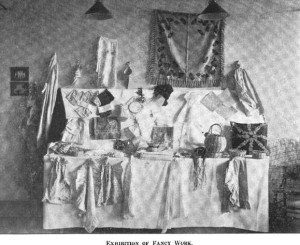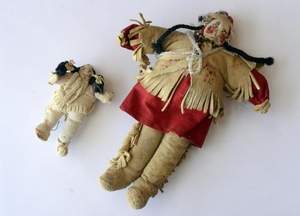
Exhibition of Fancy Work, 1908, courtesy inmatesofwillard.com
Occupational therapy was an important part of patient care in nearly all asylums. Patients were encouraged to do skilled work that got their minds off their problems/issues and produced a tangible object in which they could take pride. Genteel ladies might do fancy sewing while men engaged in woodwork, even in an elite asylum such as the McLean Asylum for the Insane in Massachusetts.
Indian patients at the Canton Asylum for Insane Indians were also encouraged to do crafts like beadwork and basket weaving if they so desired, to help pass time. (Peter Thompson Good Boy spent time “beading” at St. Elizabeths during his stay there beginning in 1913.) Occasionally, patients like Lizzie Vipont earned a little bit of money with their beadwork by selling items to visitors. Necklaces and handbags seemed to be most popular–or at least are mentioned most often. One report mentions that men whittled wooden objects, but went on to say that women were the primarily crafters. The asylum’s second superintendent, Dr. Harry Hummer, also allowed these kinds of occupations, but apparently stopped encouraging it so that the practice fell by the wayside.

This photo appeared in USA Today. Artifacts left over from the Hiawatha Insane Asylum for Indians in Canton, S.D. are displayed at the Canton Public Library on April 23, 2013. Photo: Elisha Page, Sioux Falls, S.D. Argus Leader

Occupational Therapy, Toy Making in WWI-Era Psychiatric Hospital, courtesy Otis Historical Archives, National Museum of Health and Medicine






